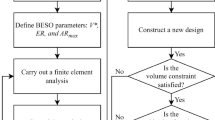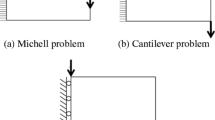Abstract
Optimal design of engineering systems with complex geometry under multiple loadings is always a challenging procedure. This paper introduces a computational interface tool between ABAQUS® and MATLAB® that can be used for carrying out the parametric optimal design of complex mechanical components. The software is developed entirely in MATLAB® environment which can handle constrained optimization problems without the need for the user to explicitly define the constraints using mathematical equations or functions. In this software, the design variables are proposed for selection through a user-friendly environment and the objective function can be iteratively evaluated by the finite-element analysis in ABAQUS®. The finite-element model is modified and updated according to the post-processing results in the ABAQUS® environment. The optimizing tool can cover metaheuristic optimization algorithms such as Genetic Algorithm in MATLAB®. Finally, the capability of the proposed tool is illustrated by investigating the optimal design of some engineering case studies.






Similar content being viewed by others
References
Arora, J.S.: Introduction to Optimum Design. Fourth. Elsevier, (2017)
Silvestre, D.: OPTool—An optimization toolbox for iterative algorithms. SoftwareX. 11, 100371 (Jan. 2020). https://doi.org/10.1016/j.softx.2019.100371
Khodaygan, S.: An interactive method for computer-aided optimal process tolerance design based on automated decision making. Int. J. Interact. Des. Manuf. (IJIDeM). 13(1), 349–364 (2019)
Mohammadi, M., Khodaygan, S.: An algorithm for numerical nonlinear optimization: Fertile field algorithm (FFA). J. Ambient Intell. Humaniz. Comput. 11(2), 865–878 (2020). https://doi.org/10.1007/s12652-019-01598-3
Madrid, J., et al.: Automated and interactive evaluation of welding producibility in an multidisciplinary design optimization environment for aircraft components. Int. J. Interact. Des. Manuf. (IJIDeM). 15(4), 463–479 (2021)
Khodaygan, S., Mehdi, B.O.H.L.O.O.L.Y.: Multi-objective optimal design of stiffened laminated composite cylindrical shell with piezoelectric actuators. Int. J. Interact. Des. Manuf. (IJIDeM). 14(2), 595–611 (2020)
Khatir, S., Abdel Wahab, M.: A computational approach for crack identification in plate structures using XFEM, XIGA, PSO and Jaya algorithm. Theor. Appl. Fract. Mech. 103, 102240 (2019). https://doi.org/10.1016/j.tafmec.2019.102240
Larsson, R.: Methodology for Topology and Shape Optimization: Application to a Rear Lower Control Arm. ” CHALMERS UNIVERSITY OF TECHNOLOGY (2016)
Li, H., Shyu, G.: “An Evaluation of Associative Interface for SolidWorks and ABAQUS / CAE,” in SIMULIA Customer Conference, pp. 1–19. (2010)
Luo, L., Zhao, M.: The secondary development of ABAQUS by using python and the application of the advanced GA. Phys. Procedia. 22, 68–73 (2011). https://doi.org/10.1016/j.phpro.2011.11.010
Gassara, F., Hambli, R., Bouraoui, T.: Optimization of springback in L-bending process using a coupled Abaqus / Python algorithm. Int. J. Adv. Manuf. Technol. 61–67 (2009). https://doi.org/10.1007/s00170-008-1819-4
Papazafeiropoulos, G., Muñiz-Calvente, M., Martínez-Pañeda, E.: Abaqus2Matlab: A suitable tool for finite element post-processing. Adv. Eng. Softw. 105, 9–16 (2017). https://doi.org/10.1016/j.advengsoft.2017.01.006
Turnbull, H., Omenzetter, P.: Fuzzy finite element model updating of a laboratory wind turbine blade for structural modification detection. Procedia Eng. 199, 2274–2281 (2017). https://doi.org/10.1016/j.proeng.2017.09.258
Skalomenos, K.A., Papazafeiropoulos, G.: “A computational method for performing nonlinear adaptive pushover analysis of structures through Abaqus Simulation,” pp. 3955–3964, doi: (2019). https://doi.org/10.7712/120119.7199.19194
Sun, Y., West, R.L., Canfield, R.A.: A Structural Optimization Scripted Software System A Structural Optimization Scripted Software System. ” Virginia Polytechnic Institute and State University (2019)
Rahman, M.M., Mohyaldeen, H.M., Noor, M.M., Kadirgama, K., Bakar, R.A.: “Robust design of suspension arm based on stochastic design improvement,” in ICMEE 2010–2010 2nd International Conference on Mechanical and Electronics Engineering, Proceedings, vol. 1, pp. V1-460-V1-464, doi: (2010). https://doi.org/10.1109/ICMEE.2010.5558508
Author information
Authors and Affiliations
Corresponding author
Additional information
Publisher’s Note
Springer Nature remains neutral with regard to jurisdictional claims in published maps and institutional affiliations.
Electronic supplementary material
Below is the link to the electronic supplementary material.
Rights and permissions
Springer Nature or its licensor (e.g. a society or other partner) holds exclusive rights to this article under a publishing agreement with the author(s) or other rightsholder(s); author self-archiving of the accepted manuscript version of this article is solely governed by the terms of such publishing agreement and applicable law.
About this article
Cite this article
Ranjbaran, P., Khodaygan, S. An interface tool for finite element–based optimal design. Int J Interact Des Manuf 18, 375–383 (2024). https://doi.org/10.1007/s12008-023-01498-z
Received:
Accepted:
Published:
Issue Date:
DOI: https://doi.org/10.1007/s12008-023-01498-z




